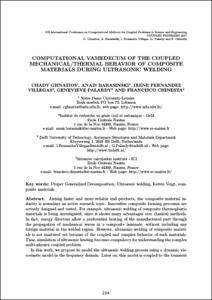Computational vamedecum of the coupled mechanical/thermal behavior of composite materials during ultrasonic welding

Estadístiques de LA Referencia / Recolecta
Inclou dades d'ús des de 2022
Cita com:
hdl:2117/190502
Tipus de documentText en actes de congrés
Data publicació2017
EditorCIMNE
Condicions d'accésAccés obert
Tots els drets reservats. Aquesta obra està protegida pels drets de propietat intel·lectual i
industrial corresponents. Sense perjudici de les exempcions legals existents, queda prohibida la seva
reproducció, distribució, comunicació pública o transformació sense l'autorització del titular dels drets
Abstract
Aiming faster and more reliable end products, the composite material in-
dustry is nowadays an active research topic. Innovative composite forming processes are actively
designed and tested. For example, ultrasonic welding of composite thermoplastic materials is
being investigated, since it shows many advantages over classical methods. In fact,
energy directors allow a preferential heating of the manufactured part through the
propagation of mechanical waves in a composite laminate, without including any foreign
material in the welded region. However, ultrasonic welding of composite materi- als is not
mastered yet because of the coupled and complex behavior of such materials. Thus,
simulation of ultrasonic heating becomes compulsory for understanding the complex multi-physics
coupled problem.
In this work, we propose to model the ultrasonic welding process using a dynamic vis- coelastic
model in the frequency domain. Later on, this model is coupled to the transient heat equation, giving the temperature field as well as the heat flux in the simulated part.
However, the result depends on the chosen experimental and material parameters such as
the thickness of the part, its viscosity, its modulus of elasticity, the imposed frequency and
displacement... Which makes the optimization of the process a tricky issue requiring a new set of
solutions of the problem for each choice of the process parameters.
Using the proper generalized decomposition (PGD), along with a coupled viscoelas-
tic/thermal model, where all the parameters mentioned above are included as extra co-
ordinates of the problem, appears to be a suitable solution for the optimization problem. Moreover,
the PGD multidimensional solution considering all the process parameters as extra coordinates
is obtained within a realistic timeframe. In fact, by using the PGD, we alleviate the
curse of dimensionality since the PGD performs a separation of variables which reduces the
problem dimensionality [1]. The result is therefore a computational vademecum that can be
used to explore in real time the solution of the problem for any
choice of the process parameters, speeding up its optimization [2].
ISBN978-84-946909-2-1
| Fitxers | Descripció | Mida | Format | Visualitza |
|---|---|---|---|---|
| Coupled-2017-23 ... demecum of the coupled.pdf | 1,237Mb | Visualitza/Obre |

